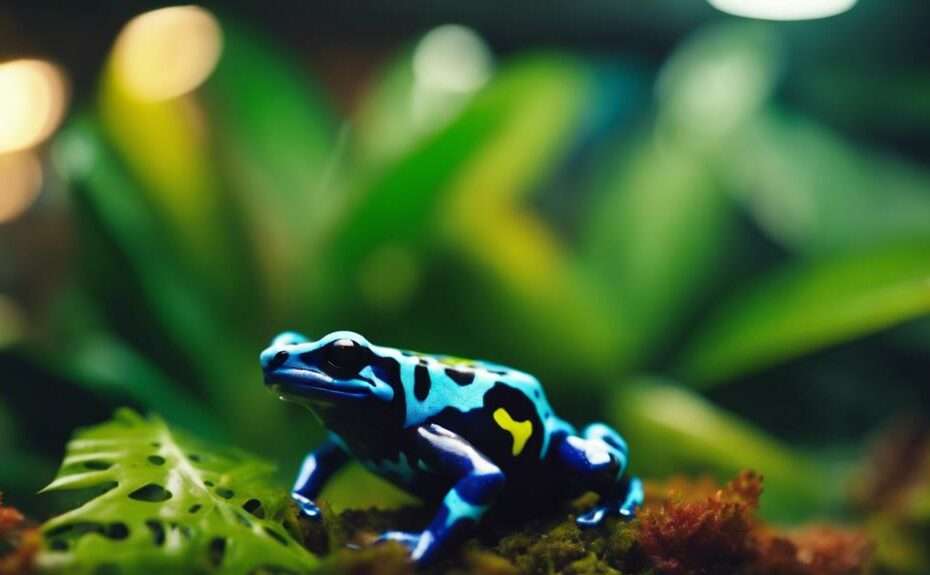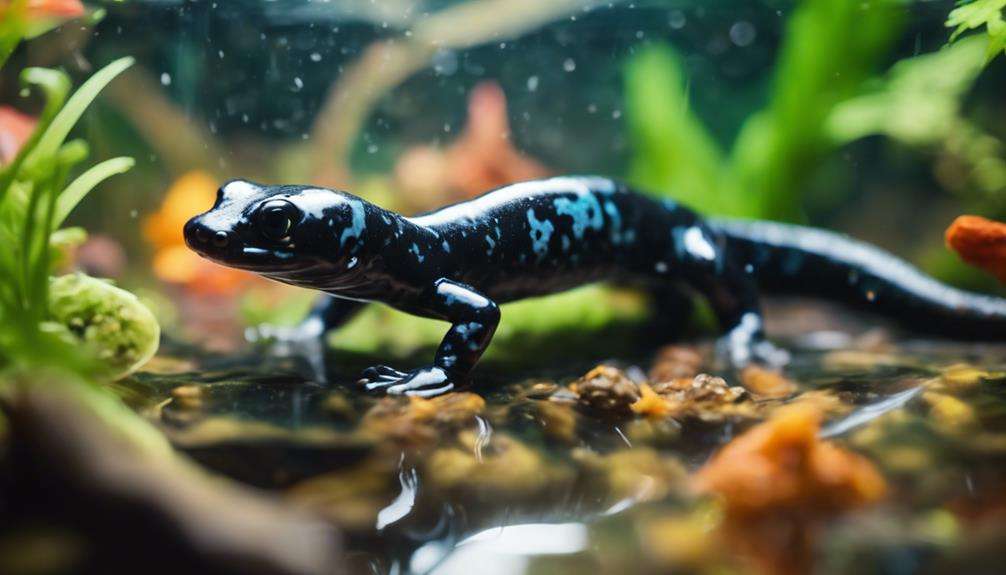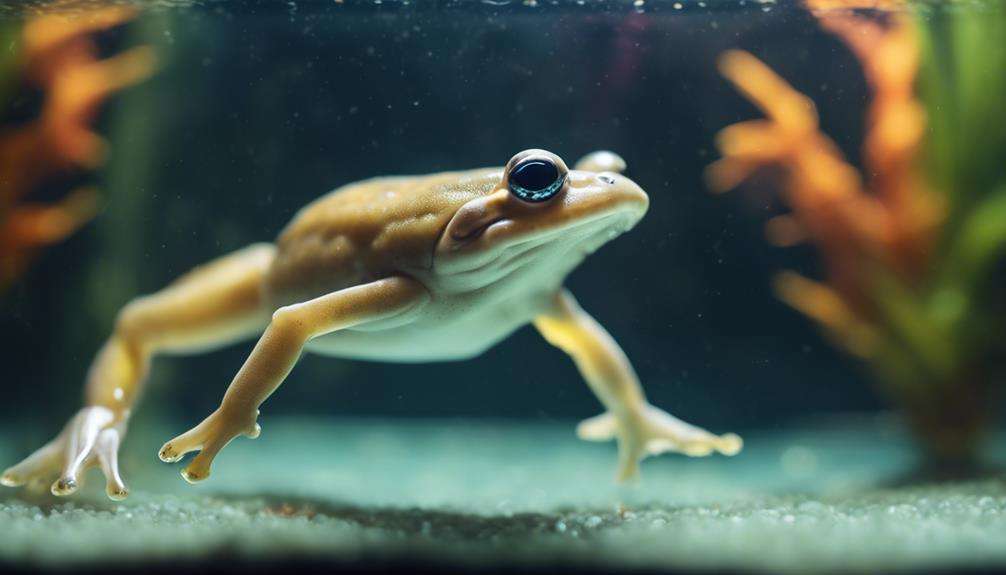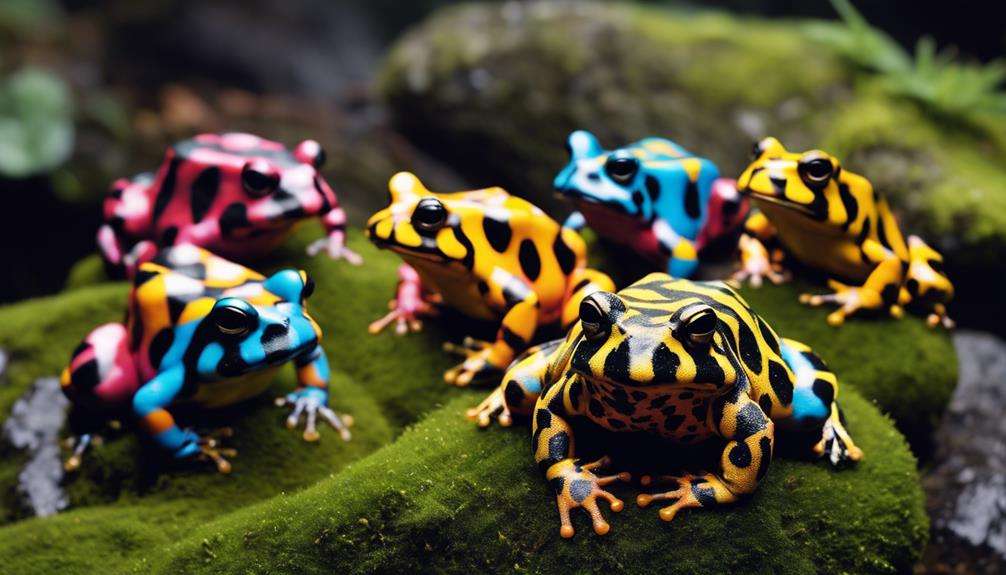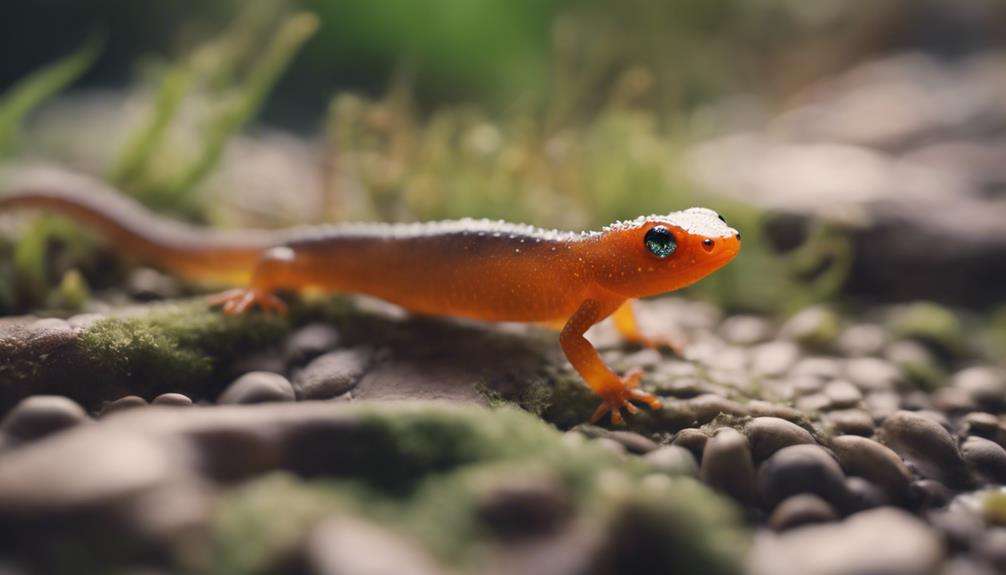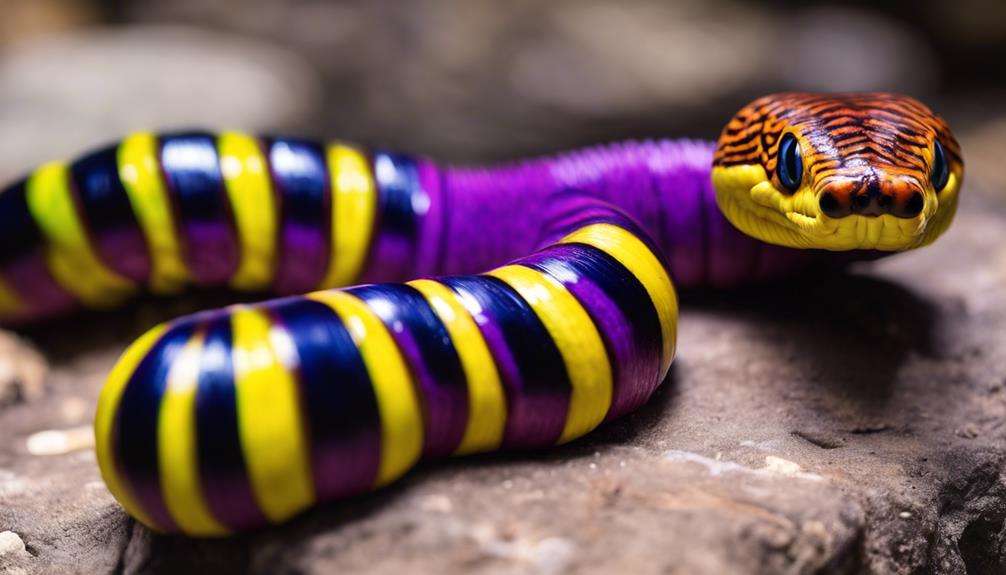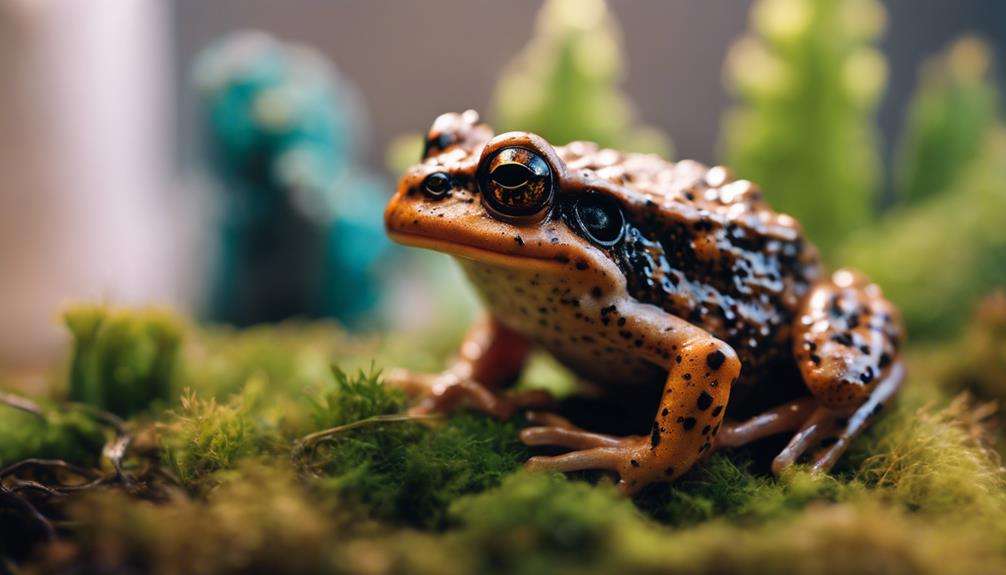You might wonder why colorful amphibians are so popular as pets when other species are available. However, the vibrant hues of these amphibians serve more than just an aesthetic purpose.
Their striking colors play a crucial role in their survival in the wild and captivate pet owners for various reasons.
Stay tuned to discover the fascinating reasons behind the allure of colorful amphibians as sought-after pets.
Key Takeaways
- Colorful amphibians like poison dart frogs are sought after for their vibrant and toxic skin secretions.
- Their dazzling array of bright colors and bold patterns serve as a warning to predators, adding allure.
- Unique color combinations and rare patterns contribute to their popularity among collectors and enthusiasts.
- The captivating allure of vibrant color combinations in amphibians drives significant demand in the pet industry.
Colorful Amphibians: A Unique Appeal
Colorful amphibians exhibit a unique allure that captivates pet owners and enthusiasts alike, drawing attention with their vibrant and eye-catching hues. Poison dart frogs, known for their striking colors and toxic skin secretions, are highly sought after in the pet trade. These small amphibians display a dazzling array of bright colors, ranging from vivid reds and yellows to electric blues and oranges. Their bold and eye-catching patterns serve as a warning to predators of their poisonous nature, making them both beautiful and dangerous.
In the pet trade, these colorful amphibians are valued not only for their aesthetic appeal but also for the sense of wonder and fascination they bring to their owners. Their stunning colors add vibrancy to any collection, making them popular choices for those looking to create visually stunning displays. As captivating creatures that demand attention, poison dart frogs exemplify the allure of colorful amphibians in the world of exotic pets.
Rare Color Combinations in Amphibians
Rare color combinations in amphibians, such as the vibrant red and blue of the Oophaga pumilio dart frog, capture your attention due to their distinctiveness and rarity. These unique color patterns not only add to the aesthetic appeal of the amphibians but also contribute to their popularity among collectors and enthusiasts.
The striking hues and unusual combinations make these amphibians highly sought after in the pet industry, appealing to those looking for visually captivating and extraordinary species to keep.
Unique Color Patterns
Observing amphibians with unique color patterns reveals a fascinating array of rare combinations that captivate enthusiasts and collectors alike. These distinctive color patterns make certain species, like the poison dart frog, particularly appealing in the pet trade due to their bright colors and intricate designs.
The following unique color patterns contribute to the allure of these amphibians:
- Iridescent blues that shimmer in the light
- Vibrant reds that catch the eye
- Neon yellows that glow under UV light
- Intricate stripes, spots, and marbling that create mesmerizing visuals
- Metallic sheens, fluorescent hues, and contrasting patterns that make each individual amphibian a work of art
These exotic color variations and uncommon morphs add to the charm of keeping these unique creatures.
Attractiveness to Owners
Amphibians with uncommon color combinations exhibit a visually striking allure to pet owners and collectors alike. Frogs, particularly poison dart frogs, with vibrant reds, blues, and yellows, captivate enthusiasts with their unique and rare color patterns. These colorful amphibians, adorned with intricate designs and contrasting hues, stand out for their desirability as pets.
The exotic color variations seen in poison dart frogs, including iridescent shades and fluorescent tones, further enhance their attractiveness to collectors. Notably, unusual color morphs like albino or patternless individuals are highly sought after for their rarity and aesthetic appeal.
The diverse range of color pigments and patterns found in these amphibians, from bold stripes to intricate spots, contributes significantly to their allure and popularity among hobbyists.
Popularity in Pet Industry
The captivating allure of vibrant color combinations in certain amphibian species is evident in the significant demand they command within the pet industry. Poison dart frogs, known for their bright colors, are particularly popular among enthusiasts for their striking appearances. In the pet trade, these colorful amphibians with unique and vivid hues stand out for their attractiveness and aesthetic appeal.
The pet industry values exotic and uncommon color variations in amphibians, such as iridescent hues and metallic sheens, which attract collectors and hobbyists alike. Additionally, the limited availability of certain color mutations, like albino, leucistic, and piebald varieties, contributes to the high demand for these visually appealing pets.
Exotic Amphibians: Vibrant Pet Choices
Exotic amphibians present a captivating array of vibrant pet choices, displaying a stunning variety of colors and patterns. Dart frogs, known for their toxic secretions in the wild, come in a mesmerizing spectrum of colors ranging from vibrant reds and blues to striking yellows and oranges. These poisonous frogs have evolved their bright hues as a warning to potential predators of their toxicity.
Tree frogs, on the other hand, exhibit a different kind of beauty with their large, colorful eyes and vibrant green bodies that aid in camouflage among the foliage.
The diversity of colors and patterns seen in these exotic amphibians is a result of intricate evolutionary adaptations for survival and reproduction. The striking appearance of these amphibians not only adds visual interest to vivariums but also serves as a testament to the wonders of nature's artistic creations. Owning these colorful creatures as pets allows enthusiasts to appreciate the beauty and complexity of the natural world up close.
Brightly Hued Amphibians for Enthusiasts
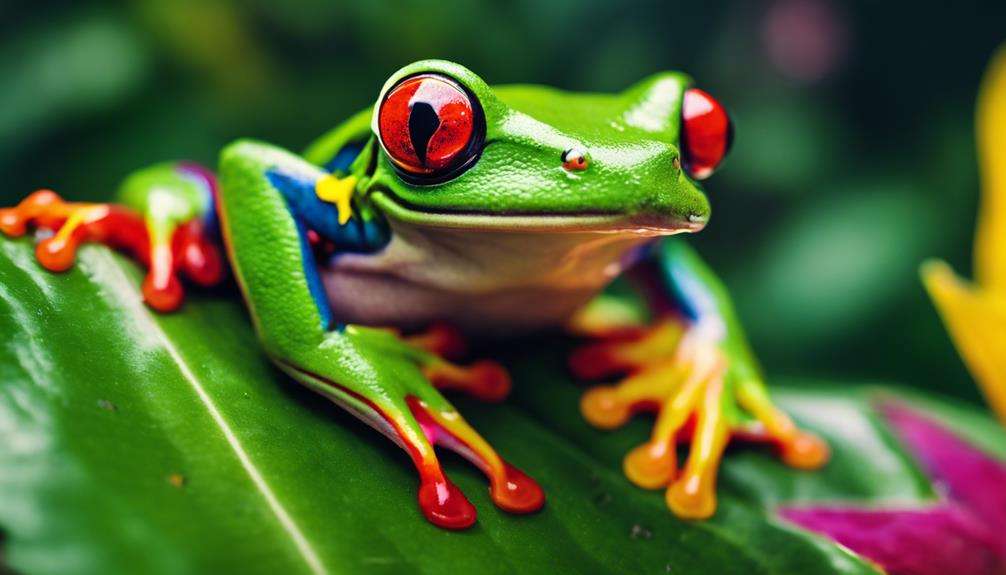
With their vibrant hues and captivating patterns, these colorful amphibians are highly sought after by enthusiasts seeking to add a pop of color to their vivariums. These brightly hued amphibians, such as dart frogs and tree frogs, are popular among pet keepers for their striking coloration. Here are some key points to consider about these colorful creatures:
- Dart frogs, known for their toxic skin secretions, come in a variety of bright colors, including red, blue, yellow, and green.
- The vivid hues of these frogs serve as a warning to predators about their toxicity, making them both beautiful and functional additions to a vivarium.
- Tree frogs, like the Red-eyed Tree Frog, boast vibrant green bodies with striking red eyes, captivating enthusiasts with their unique appearance.
- Pet keepers are drawn to these amphibians for their diverse range of colors and patterns, allowing for visually appealing setups in their habitats.
- The allure of these brightly hued amphibians lies in their ability to bring a sense of vibrancy and life to any collection, making them highly sought after in the pet trade.
The Allure of Colorful Frog Species
Colorful frog species present an array of vibrant and eye-catching hues that captivate enthusiasts and collectors alike, enhancing the visual appeal of vivariums.
Among these captivating amphibians, poison dart frogs stand out with their bold and striking colors. These frogs utilize their bright hues as a form of aposematic coloration to warn predators of their toxic nature. By showcasing vibrant shades of red, blue, yellow, and green, poison dart frogs advertise their toxicity, deterring potential threats in their natural habitats. This evolutionary adaptation is crucial for the survival of these animals, as it helps them avoid predation.
Furthermore, the use of bright colors in poison dart frogs serves as a visual signal within their species, aiding in mate selection and communication. The alluring colors of these frogs not only make them visually stunning pets but also highlight the fascinating ways in which animals use coloration in nature.
Unique Pigmentation in Pet Amphibians
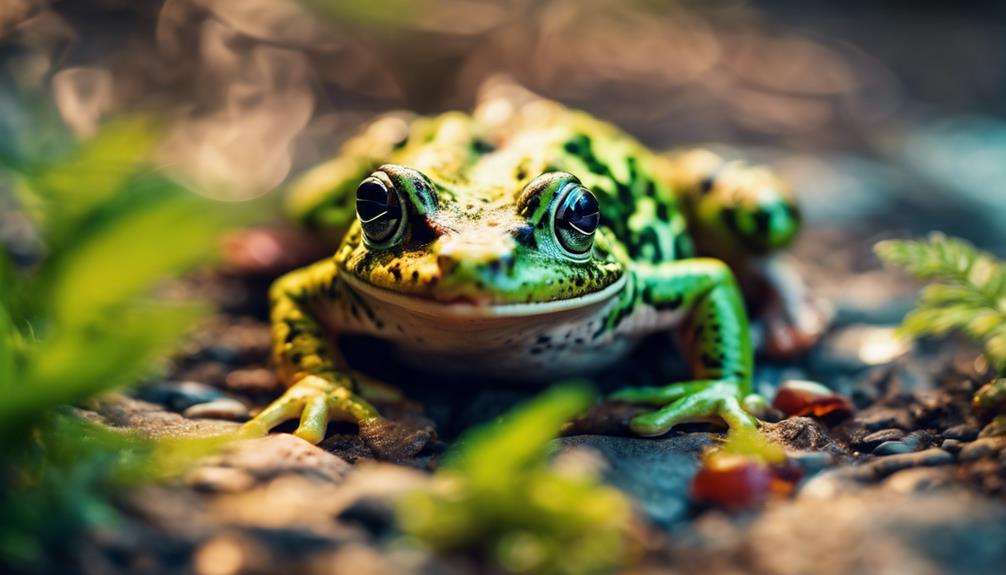
When examining the unique pigmentation in pet amphibians, one can appreciate the intricate color genetics that contribute to their vibrant hues.
Various color morphs, such as albino and melanistic variants, showcase the fascinating diversity in amphibian pigmentation.
Observing these popular color variations can offer insights into the genetic mechanisms behind the striking hues seen in pet amphibians.
Color Genetics in Amphibians
Specialized skin cells in amphibians intricately produce a diverse array of skin colors, driven by complex interactions of pigments like melanin, carotenoids, and guanine crystals. These color genetics in amphibians lead to the vibrant hues and patterns observed in popular pet species. Understanding the genetic factors behind skin color genetics can help breeders selectively enhance and preserve unique pigmentation traits in captive populations.
Some amphibians possess iridophores that reflect light, creating iridescent colors on their skin. These genetic variations contribute to the mesmerizing and unique appearances of pet amphibians like dart frogs and tree frogs. By delving into the intricacies of color genetics, enthusiasts can appreciate the beauty and diversity found in these fascinating creatures.
Popular Color Morphs
The intricate interplay of genetic factors in amphibians results in a remarkable array of color morphs that exhibit stunning and unique pigmentation patterns.
In particular, poison dart frogs, sought after in the pet trade, showcase popular color morphs like albino, leucistic, piebald, and melanistic. These variations, arising from genetic mutations, produce captivating and visually striking amphibians.
Albino morphs lack melanin pigment, appearing white or pale yellow. Leucistic morphs display reduced pigment cells, resulting in a partial loss of coloration. Piebald morphs exhibit irregular patches of color against a white background. Melanistic morphs, on the other hand, have an excess of melanin pigment, appearing darker than usual.
Breeders selectively propagate these color morphs to meet the demand for unique and visually appealing pet amphibians.
Sought-After Color Patterns in Amphibians
Sought after by enthusiasts for their captivating and unique coloration, colorful amphibians display a variety of vibrant patterns that make them highly desirable as pets. These sought-after color patterns include:
- The red-eyed tree frog with its green body and striking red eyes.
- Dart frogs, renowned for their diverse color combinations and patterns.
- The yellow and black dart frog's stunning contrast of bright yellow and black coloration.
- The oriental fire-bellied toad, featuring a bright green body and yellow/orange underbelly.
- The Amazon milk frog, characterized by a light grey body and distinctive banding.
Each of these amphibians showcases a unique and attractive appearance, drawing in hobbyists and collectors alike. Whether it's the vivid hues or the intricate designs, these vibrant patterns contribute to the desirability of these amphibians as pets, adding a splash of color and intrigue to any collection.
Frequently Asked Questions
What Is the Best Amphibian to Have as a Pet?
If you're considering an amphibian pet, the best choice depends on your preferences. Care requirements, best habitats, and handling tips vary among species. Research and choose based on what fits your lifestyle and interests.
What Is so Special About Amphibians?
Amphibians are fascinating due to their unique adaptations like skin breathing, metamorphosis, and color-changing abilities. They play crucial roles in ecosystems, indicating environmental health. Conservation efforts are vital to protect these diverse species from threats.
Why Are Some Amphibians Brightly Colored?
Brightly colored amphibians possess an evolutionary advantage through warning colors that signal toxicity levels, serving as a deterrent to predators. Their vibrant hues also aid in camouflage strategies, allowing them to blend into their environment for protection.
What Are the Advantages of Amphibians as Animal Models?
Amphibians serve as valuable animal models for research due to their biological similarities to humans. Their permeable skin aids in drug delivery studies. Regenerative abilities offer insights into tissue healing. They are pivotal in environmental indicators and genetic pathways.
Conclusion
You have witnessed the captivating beauty of colorful amphibians, their vibrant hues enchanting you with every glance.
Imagine owning a Poison Dart Frog, its dazzling colors warning predators of its toxicity while adding a splash of brilliance to your home.
As you observe its unique pigmentation and rare color combinations, you can't help but feel a sense of wonder and awe at the stunning beauty of these exotic creatures.
Truly, colorful amphibians are a sought-after treasure for any enthusiast.
